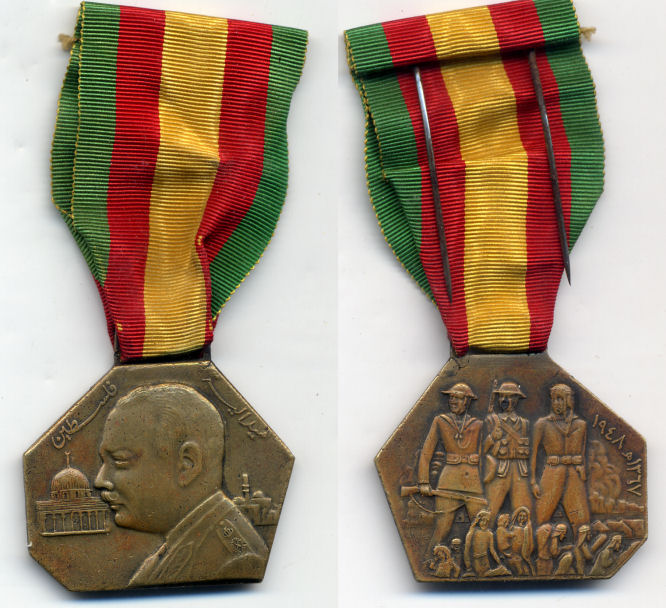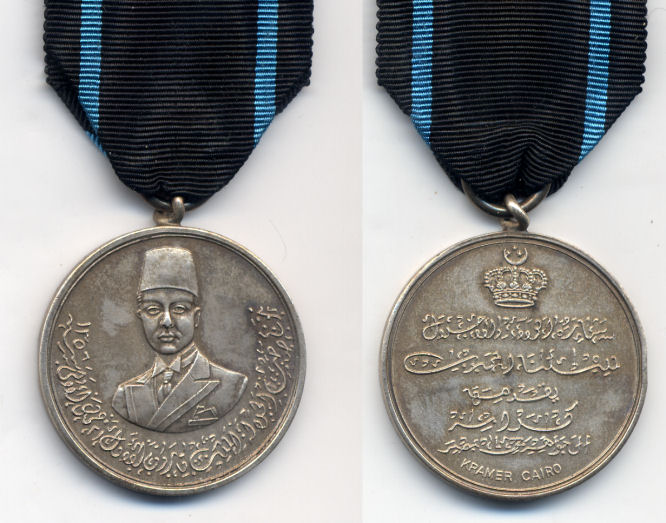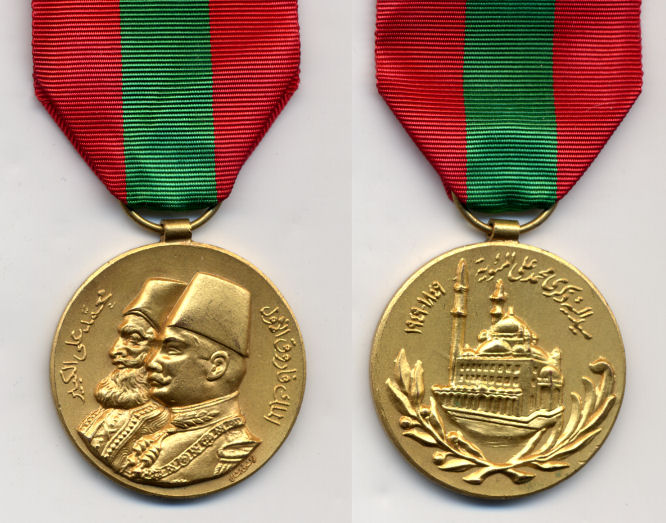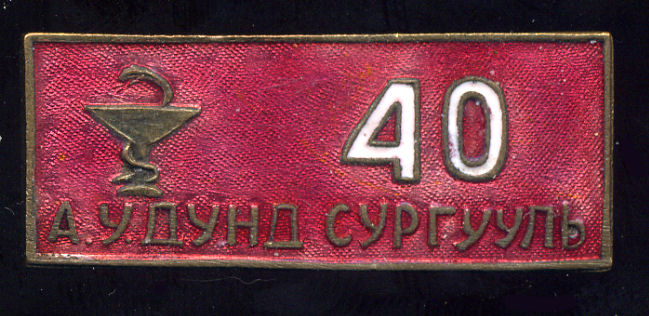-
Posts
14,343 -
Joined
-
Last visited
-
Days Won
25
Content Type
Profiles
Forums
Blogs
Gallery
Events
Store
Posts posted by Ed_Haynes
-
-
Medalyet Falasteen / Palestine Medal
Awarded to Egyptian armed forces personnel who served in the 1948-49 Arab-Israeli War. In 1953, with the revolution, the design of the medal was altered, with the earlier reverse being worn as the obverse of the medal.
Established: 1948?, revised ????
Obverse: 36 x 45 mm, bronze, seven-sided, with unequal sides, seeming "off balance" to the left (until 1953). first variety: King Faruq facing left [not, as it has sometimes been described, Nasser!], between the Egyptian parliament building (to the right) and the Al-Aqsa mosque in Jerusalem (to the left); above "Medalyet / Falasteen", or "Palestine / Medal". second variety: three soldiers, with civilians gathered around them, dated "1948-1347" or "1948-1347" (the reverse of the pre-1953 variety).
Reverse: first variety: three soldiers, with civilians gathered around them, dated "1948-1347" or "1948-1347" (the obverse of the post-1953 variety). second variety: blank.
Ribbon: 35 mm, equal stripes (5 mm each) of green, red, yellow, red, green. A brass lotus blossom has been observed worn on ribbon bars representing this medal, though it is unknown what this represents.
first variety with the king on the obverse (shown below)
second variety with the old reverse moved to the obverse


 1
1 -
Twentieth Anniversary of the Revolution
Commemorating the 20th anniversary of the revolution, 1972.
Established: 1972?
Obverse: Circular 33 mm bronze medal, in the center the eagle of the republic, surrounded by twenty stars. Above, the Arabic inscription and, below, a wreath. Suspended by a ring suspension.
Reverse: A scene of a muscular arm holding a submachine gun and, behind, a hydroelectric dam (Aswan) and sun rising over a building on a hill (the Muhammad Ali Mosque in Cairo?).
Ribbon: 36 mm, light blue with edge stripes (reading inward) of black, white, red, and central stripes of (left to right) red, white, black. Black 2? mm, white 2 mm, red 2 mm, light blue 7 mm, red 3? mm, white 2 mm, black 3? mm, light blue 7 mm, red 2 mm, white 2 mm, black 2? mm. When worn as a ribbon bar, a circular brass disk with "20" ("20") is usually added to the ribbon bar.


 1
1 -
Medal for the Coronation of King Faruq, 1936
King Faruq was crowned as "King of Egypt and Sudan, Sovereign of Nubia, of Kordofan and or Darfur" on 28 April 1936. King Faruq abdicated after the revolution on 23 July 1952 and died in Rome on 18 March 1965.
Established: Manufactured by Kramer (Cairo, Egypt).
Obverse: Silver, 35 mm circular medal. Facing portrait of the king wearing fez and tuxedo, below, an Arabic inscription. Suspended by a ring.
Reverse: At top, a crown with crescent with three stars above. A five-line Arabic inscription. Below, "KRAMER CAIRO".
Ribbon: 36 mm, black with two thin medium blue stripes. Black 4 mm, medium blue 3 mm, black 22 mm, medium blue 3 mm, black 4 mm.


 1
1 -
Medal of Muhammad Ali
Awarded for service 19-26 November 1949. Commemorating the centenary of Muhammad Ali. Revised under the Republic?
Established: By King Faruq, November 1949, later revised and continued under the Republic.
Ribbon: 1?" moir? equal stripes of red, dark green, red.

 1
1 -
Wisam Nigam al-'Askariia / Military Star
The Military Star of Fuad I was originally intended for award to Egyptian and foreign officers for mention in dispatches or distinguished service in the field or before the enemy, with courage and a spirit of self-sacrifice. In broad terms, the Military Star can be seen as having been patterned after the British Distinguished Service Order. It was, of course, redesigned with the fall of the monarchy. With the redesign and restructuring which came with the 1952 revolution, the award came to be awarded to any officer for exceptional service with courage and a spirit of self-sacrifice. Whenever possible, the award is to be personally presented by the president of the republic. The star can be awarded posthumously or to foreigners.
Established: By King Ahmad Fuad I in Royal Order of 6 December 1919, revised and redesigned on 9 July 1953 and amended by Law No. 12 of 1972.
Obverse: A five-pointed gilt star, enameled white. The center is enameled blue with crossed swords in gilt, surrounded by a red circlet with a gilt wreath. Above all a gilt crown. Suspended from a straight bar suspender. After 1953, the 45-mm star has been of bronze with blue-enameled points, with the center swords replaced with the Egyptian eagle (after 1971, hawk), and the suspension crown removed. Each point has two crossed swords. The suspension is a ornate enameled bar in the form of a pair of "Pharonic" falcon's wings, with a disk in the center bearing a pair of crossed swords.
Reverse: Until 1953, a gold Arabic inscription on purple enamel. Afer 1953, plain except for award details and the serial number of the decoration.
Ribbon: 37 mm, moir?, five equal 6 mm stripes of blue, yellow, black, yellow, blue, with thin (1 mm) yellow edges.
Military Star of Fuad I, 1919-1953
Military Star, 1953--
Egyptian eagle, 1953-58
U.A.R. eagle, 1958-71
hawk, post-1971 (shown below?)

 1
1 -
Continuing the Arab country-by-country threads.
A few sources to start with:
http://faculty.winthrop.edu/haynese/medals/egypt.html
http://www.medals.org.uk/egypt/egypt.htm
http://www.omsa.org/photopost/showgallery.php?cat=691
http://www.medals.lava.pl/eg/eg2.htm
0 -
Would that there were!
The guy who runs D-Day Militaria, whose name escapes me (but Jeff Floyd should remember), has a book listing Belgian awards to Americans. The page for that book has the basic statistics: http://www.ddaymilitaria.com/belgium_ww2.htm
I haven't seen anything for other countries.
Thanks, Dave. Grumble . . . .
0 -
Thanks, Daniel. Is there a similar WWII listing?
0 -
Add a datapoint:
Hero of Labour Gold Soyombo 79 13/10/1966
0 -
0
-
OK, I knew I'd seen it some place before:
http://gmic.co.uk/index.php?showtopic=9297&st=18
http://gmic.co.uk/index.php?showtopic=9297&st=28
Lovely one. Never seen on the market?
0 -
Thanks for doing this. Life will now become much easier for the linguistically challenged!
 0
0 -
. . . St.Pats day in Transylvania,

Quite a concept. Green Vulcan blood?
0 -
Oh, sorry.
Not a casualty (KIA). Sorry for you, not for him.
Just to show what the medal SHOULD look like:
 0
0 -
And, while exporting this is (also) illegal, it'd bring a tidy price at auction in London, I'd suspect!
Lovely group, by the way!
0 -
Ed,
Thanks again. I didn't find anything under the name I have.
Thus, I assume that such guy never was not awarded, as it was told me.
Regards,
Douglas.
Not finding him there is not a certainty, but this does have the smell of a "buy the medal, not the story" situation.
0 -
Ed,
Thanks once more for the tip. However, I have been checking the site but it seems that the tools available only allow the search regarding the VC, MC, DCM and MSM. I assume that will be necessary to contact them by e-mail about the MM. The surname is not a common one
 .
.Wishes,
Douglas.
No, you can just enter the surname without any decoration indicated and set it for the years desired. There may be some looking and, as I say, the system is far less than perfect. Still, better than using the paper index to the LG.
0 -
Nice!! Central and South America is an especially "information-free" area. Anything helps A LOT!
0 -
Ed,
I'm afraid, nothing related to Arthus-Bertrand...
Ch.
I know, Christophe, I was grasping at anything I could. I see no reason to expect "Asian", so the mystery stands.
0 -
How could I have missed this one?
Welcome to the collecting of Indian medals, Rick! Welcome over from The Dark Side!!
A new addiction, a new slippery slope, always room for one more.
 0
0 -
While it is fairly cranky to use, the online London Gazette -- http://www.gazettes-online.co.uk/archiveSearch.asp?WebType=0 -- can be used to search for gallantry award winners. If the surname isn't too common, this should be the way to go.
0 -
Greetings all,
Here is an analysis that was posted on the OMSA forum regarding the Stolen Valor Act. I guess the FBI need a real job so we U.S. collectors are the new targets.
Ron

Good. It has not been linked three times. Read it three times.
0 -
And here a nice little (thumbnail sized - makes you wonder who actually used to wear these) Chinese badge: "Long Live the Friendship between China & Albania"
Nice badge for Sino-Albanian friendship. Have to ask a good friend in Shanghai who was one of half-a-dozen Chinese trained in Albanian and employed as a government translator back in the day when only Albania and China spoke to each other.
0 -
R 35 -- 40 Years of the Medical School


 0
0




ARAB MEDALS -- Egypt
in Middle East & Arab States
Posted
Medal of Distinction
Awarded to those who render valuable service to the state, especially in the fields of acience, arts, literature, agriculture, industry, commerce, sports, public services, and public order and security.
Established: Established in 1966 and classified as a civil medal by Law No. 12 of 1972.
Obverse: Circular 35-mm medal, a metaphorical scene depicting the beneficial spread of knowledge and culture among the people. (???!) Suspended by a straight bar from a ring in the form of an ancient Egyptian helment (crown?). (This description is pretty forced, but it is "official" = gag.)
Reverse: The name of the medal, above an indication of the class and, below, the date of creation.
Ribbon: 37-mm moir?, white with 10-mm green edge stripes: 10 mm green, 17 mm white, 10 mm green.
first class - gilt (shown below)
second class - silver
third class - bronze